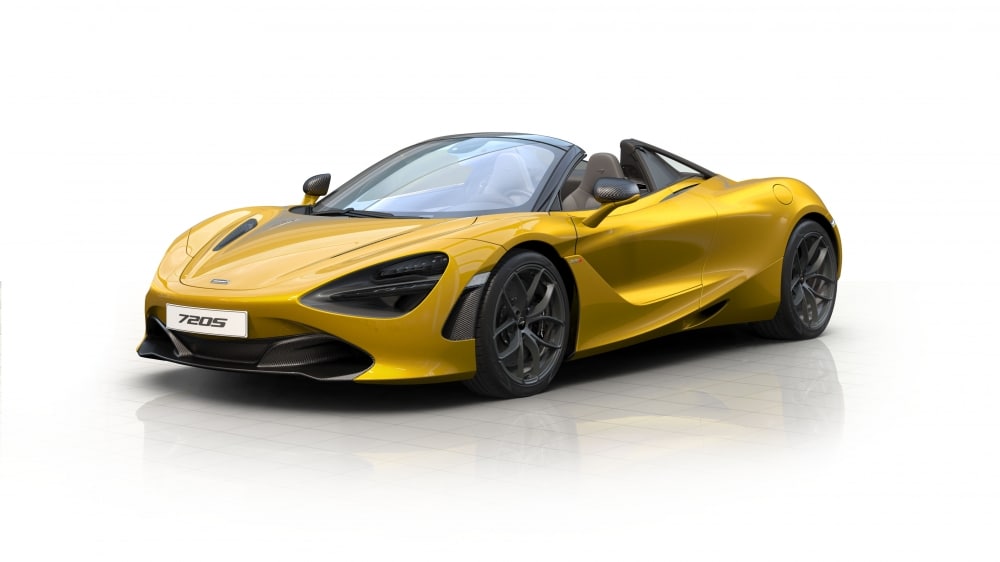As great British automotive success stories go, they don’t get much better than McLaren’s. In little more than nine years, the firm has accelerated from generating ‘just’ £6million a year in revenue from its car business to these days racking up more than £800million annually. That meteoric rise has been largely thanks to its core super series range, which the 720S Spider joins as the latest member.
Launched in 2010 as the MP4-12C – taking on the Ferrari 458 head on – the core of McLaren’s supercar range has evolved into the incredibly accomplished car you see here.
What’s new?
With a clever folding roof, designed to collapse in one gracious movement in just 11 seconds, the 720S Spider lets owners drop the lid at speeds of up to 31mph. It’s a stunning design that once lowered – an action that takes place in near silence – allows the exhaust note to fill the cabin. And when the roof’s up, it has another trick up its sleeve: An optional electrochromic glass panel can be specified that rapidly changes between tinted and transparent at the touch of a button, letting drivers enjoy the skyline even with the comfort of the roof in place.
To further aid the design, McLaren has created the flying buttresses – those aerodynamic wings that extend out behind the rollover bars – from glass, which not only look stunning but also increase visibility when the driver looks over his or her shoulder.
What’s under the bonnet?
McLaren’s tried-and-tested 4.0-litre twin turbo-charged V8 produces 710bhp and 770Nm of torque. Those heady figures are enough to propel it to 60mph in 2.7 seconds and on to a top speed of 212mph with the roof shut and 202mph with it down.
The addition of the roof, despite the extra 49kHg on the overall kerb weight, has had little effect on performance. The Spider will still hit 124mph in just 7.9 seconds, a 0.1 second blink of an eye less than the Coupe. A standing quarter-mile is completed in 10.4 seconds – again, just 0.1 seconds slower than its hard-top equivalent.
What’s it like to drive?
Importantly, the removal of the roof hasn’t compromised handling. Thanks to the same carbon tub from the Coupe used here – the Spider was developed alongside its hard-top sibling from the start – there’s no discernible difference in rigidity. It rides superbly, soaking up even the nastiest of bumps on our Arizona test drive.
On the road the 720S is an accomplished supercar. The seven-speed automatic gearbox shifts cogs in milliseconds and is an absolute joy to use in manual mode. The carbon paddles are mounted on a rocker, a pull on the right lever depressing the left, and vice versa. F1 technology has been used to cut the ignition spark to improve shift changes too, which is especially noticeable on down shifts.
Several drive modes can be selected, depending on your mood, with gear shift, steering, transmission and electronic safety nets all modified to suit. Comfort, sports or track options can be selected that dramatically alter the car’s behaviour.
How does it look?
With those dramatic glass flying buttresses, stunning frameless dihedral doors and active rear spoiler, the 720S Spider looks every bit the supercar.
McLaren engineers have focused on form going hand in hand with function as regards the design. Sculpted around the air intakes that cool the engine and brakes, it’s purposeful and visually arresting. Pedestrians stop, gawping as it rolls past like something that’s come from outer space.
What’s it like inside?
It feels like there’s a little less room inside the cabin. Taller people might find themselves cramped in both the driver and passenger seats. The multi-adjustable seats just don’t seem to have enough adjustment to get truly comfortable. That said, the cabin is a plush place to spend time.
There’s a choice of four leather interiors, with a leather steering wheel, eight-inch infotainment system and a cool folding digital driver display that tucks away to reveal just a rev counter when ‘track’ mode is selected from the dynamics panel. The latter offers multi-adjustment of the driver aids, turning the 720S Spider from comfortable cruiser into rabid race car at the twist of a dial.
What’s the spec like?
Those jaw-dropping doors, LED headlights, twin stainless-steel exhaust and five-spoke alloy wheels all come as standard. Other highlights included are dynamic stability control, dual-zone air con and keyless entry. There’s plenty to choose from the options list, though, like that electrochromic roof at a whopping £7,500, special Aztec Gold paint (£4,330), carbon seat backs (£3,280), Bowers & Wilkins audio system (£3,640) and the potential to spend many thousands more on optional carbon-fibre extras. It all depends how deep your pockets are.
Verdict
There’s little doubt how important the super series range has been to McLaren and its current crown bearer is an incredible machine. The 720S is bone-crushingly quick and simply more than you’ll ever need on the road.
Facts at a glance
Model as tested: McLaren 720S Spider
Price as tested: £246,990
Engine: 4.0L twin-turbo-charged V8
Power: 720ps (710bhp) @ 7,250 rpm
Torque: 770Nm (568lb-ft) @ 5,500 rpm
Max speed: 341kph (212mph)
0-60mph: 2.8 sec
MPG: 23.2
Emissions: 276g/km








